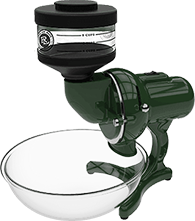Surprise: Most “Stone Ground” Flour Isn’t Really Stone Ground
You’ve no doubt seen loaves of bread and packages of flour at the store with a blurb on the wrapper saying it’s “stoneground.” Would it surprise you to learn that most of the flours advertised as “stoneground” are not actually ground by stone?
As it turns out, there are no federal requirements for use of the term “stoneground” or “stone ground” and so it’s open to interpretation by flour manufacturers. Some crack open the wheat berries on a stone, then do the actual milling on an industrial roller mill. Some just run the flour they milled in large roller mills over a stone before packaging it. And some just use the term “stoneground” because it conjures up imagery of a more wholesome time.
Doesn’t seem right, does it?
If you’re wondering why no one has done anything to try to change this, well, one US company did. In 2001, Hodgson Mill—one of the few remaining commercial mills that actually mills flour on stone mills—asked the Food and Drug Administration to issue an official definition of “stone-ground” flour7. The FDA refused, claiming there was no evidence to show the term “stoneground” matters to consumers.
The Freshest Most Wholesome Flour Is the Flour You Mill Yourself
For anyone concerned about commercial flour production, whether it’s actually stone ground or not, or the freshness of store-bought flour, there is an alternative: Home milled flour. The Lee Household Flour Mill enables you to create 100% stone ground flour right in your own home from a variety of grains. No questions, no doubts, just quality taste and nutrition.

